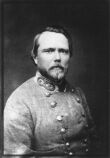|
After
the Union Army had retreated back across the Rappahanock, the two armies
went into encampments all along the river. Hill's men built Camp Gregg about
8 miles south of Fredericksburg. Life for the soldiers, as well as the citizens
of the decimated town, was horrible during the next few winter months. But
by this time, the soldiers had become accustomed to horrible conditions and
passed the days doing the things encamped soldiers did to keep busy. Barbing,
or trading with Union sentinels on the opposite shore, gambling, story telling
and bull sessions, reading, writing, scavenging for fire wood or singing
filled the day. Periodically a snowball fight might break out and everyone
would rush to join in the combat.
Hill did well under the pressure of battle, but dormancy turned him impatient.
Almost looking for a fight, he stirred up the feud between him and Jackson
once again, when he demanded his arrest by Jackson before Harper's Ferry,
be brought to a military court of review. Lee continued to try to ignore
the matter, but Hill pushed the issue until the angered Jackson, his best
corps commander, wanted Hill, his best division commander, permanently relieved
of duty.
During the winter months, new promotions were made. To replace the fallen
Gregg, Hill promoted the commander of the 14th South Carolina, Samuel McGowan,
to command the brigade. Brockenbrough had fallen short of Hill's expectation's
as a brigade commander, so Hill brought in a personal friend and native
Virginian, General Henry Heth to lead his Virginia brigade. Across the river,
loud cheers went up from the Union forces, when it was announced that Lincoln
had replaced General Burnside with General Joseph Hooker. During the early
months of 1863, Hooker rebuilt his demoralized Army of the Potomac into a
threatening force.
One of Lee's finer traits as a general, rarely considered, was his ability
to adapt to new enemies. In the early years of the war, he rarely did major
battle with the same Union commanders. This would be the fourth he now faced,
and casting a weary eye across the river, he wondered what Hooker was thinking.
In fact, as spring approached, Hooker had a plan. With some of Lee's forces
with Longstreet campaigning in southern Virginia and a few brigades transferred
to South Carolina, he felt a three prong move could break Lee. First he would
send his cavalry south to cut Lee off from Richmond. Secondly , he would
leave about a third of his forces in Fredericksburg to keep Lee busy. Thirdly,
he would take the bulk of his forces north, cross the Rappahanock and come
down on Lee's flank.
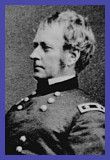
Joseph
Hooker
courtesy
General
Officers of the Civil War
By
the 29th of April, Lee was aware something was up and recalled Jackon's forces
to Fredericksburg. Hill's men trudged through the mud to the old battlefield
from months before. Thanks to Jeb Stuart, commander of the cavalry, Lee knew
by the next day what Hooker was up to. He also learned Hooker had stopped
his Army in the middle of a 12 mile by 6 mile deep forest. This was a tactical
mistake and Lee knew he must capitalize before Hooker moved out of the
wilderness. At four the next morning, except for 9000 troops under Jubal
Early left to watch Fredericksburg, Lee led the balance of his Army north.
Hooker learned of Lee's actions later that day, and it took him by total
surprise. Apparently not prepared for this contingency, Hooker pulled his
men back into the safety of the wilderness. Skirmishing at the edge of the
woods let Hooker and Lee both know they had met their foe. Night fell and
both leaders pondered. Lee knew he could not afford to do a direct assault
on the Federal's in the forest. Hooker, assured in this, seemed to ponder
his options with less urgency, keeping his Army in a defensive mode. About
midnight, Jeb Stuart reported with news. Hooker's right flank was open and
vulnerable. But already outnumbered, could Lee afford a flanking movement?
He turned to Jackson.
By 7 the next morning, Jackson was on the move. Traveling through a clearing,
Union artillery lobbed shells at Jackson's men and Hooker was alerted. At
first, he correctly ascertained Jackson's motives, but then felt Lee was
retreating. After telling Gen O.O. Howard to watch his right flank, he then
decided to attack what he felt was Jackson's retreating rear. Near Catharine
Furnace, a small metal foundry, elements of his force attacked the rear regiment,
the 34th Georgia Infantry. Gallantly holding the Union forces at bay, Thomas'
Georgians and Archer's Alabama and Tennessee troops turned back to assist.
Nearly 20M Federal's would eventually be sent to this small battle. It would
prove a serious mistake, by effectively cutting off all close support for
the exposed right flank. Hooker was convinced Jackson was retreating by this
action, and by another turn that Jackson would make when discovered at Brock
Road. Howard let his guard down, about the time Jackson was guiding his men
off the narrow path and into the wilderness. By five p.m. he had eleven of
his fifteen brigades formed in the woods along a two mile front, near a clearing
where the Union 11th Corps was camped.
The brigades that were not in line were Hill's. Thomas and Archer's brigades
had become engaged with the Federal's at Catharine's Furnace. They had been
unable to rescue the 23rd Georgia, who were mostly killed and captured.
Outnumbered nearly 15 to 1, the two brigades were bait, drawing more troops
to the firing and delaying them, giving Jackson time to move secretly ahead.
Word finally arrived to break off the rear action and join the main body.
The two brigades disappeared down the road, leaving the Federal's convinced
they had defeated Jackson. While Jackson had been forming his forces silently
in the woods to attack, the Georgian's were double timing to Jackson's location.
Of Hill's Division, only Pender's and Heth's were available for the initial
assault, the remaining brigades still making their way to Jackson's main
force.
At 5 pm a bugle pierced the silence, and nearly 30,000 yelling Confederates
poured out of the woods onto the unsuspecting Union right. Howard's eleventh
Corps, completely taken by surprise, attempted to make a stand, but each
battle line they established was broken. Howard would later write "...the
attacking force emerged from the forest and rushed on...in such multitudes
that our men went down before them like trees in a hurricane."
By 7:15 pm, the 11th Corps had been driven from the field. As sunset was
beginning to fall, Jackson reluctantly called a momentary halt to his advance.
Regiments were intermingled and needed to re-group. Jackson had no intention
of stopping though - he wanted to get to the river and cut off Hooker's escape
route before the next morning. Hill's brigades had arrived, and having not
been part of the initial assault, still maintained their formation's and
were moved to the front. Jackson wanted badly to get to the Ford during the
night. He ordered Hill's men to advance. Lane's North Carolinian's took the
lead, spreading over a half mile wide front and proceeding into the woods.
With nothing but Federal's and woods to their front, Lane gave the order
to shoot anything that moved. While Lane's men inched forward in the darkness,
Hill and Jackson moved back and forth through the woods, trying to ascertain
the Federal's location. Upon discovering them, firing broke out from the
Federal line. The nervous North Carolina troops returned a volley into the
dark. This brought on artillery fire, as troops from both sides fired blindly
into the darkness. Jackson and Hill rode through the woods back to the
Confederate line. Realizing how loud and ominous they must sound, crashing
through the trees like a cavalry, Hill rode ahead of the small entourage
yelling at Lane's men to "cease firing". Major Berry of the 18th North Carolina,
feeling it was a Union trick, ordered his troops to "pour it into them, boys".
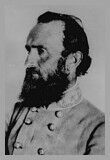
Thomas
"Stonewall" Jackson
courtesy
General
Officers of the Civil War
This
order would cost General Jackson his life, as he fell mortally wounded. Command
fell on Hill, who after spending some time with his fallen commander, brought
Thomas' Georgians up to the left of Lane's brigade, and Pender to Thomas'
left. Injured himself by an exploding artillery shell, Hill sent word to
cavalry commander James Ewell Brown "Jeb" Stuart, to assume command. As the
Hill Division stared into the wooded darkness that night, their division
commander and corps commander were taken to the rear. Stuart called off the
night assault, and moved the corps into position for an attack the next morning.
Hooker had been taken by surprise, but he knew he was still in a commanding
position. Sickle's men, the troops engaged earlier at the Furnace with Thomas'
Georgians, stood between Lee and Jackson's men. He now had the two small
Confederate forces split, and was in position to beat either. It never happened.
Stuart planned to attack Hazel Grove, a small clearing of high ground the
next morning. For some reason, Hooker withdrew from this area during the
night, and handed a surprised Stuart, the high ground he needed for his artillery
the next morning.
The next morning saw some of the fiercest fighting of the war yet. Starting
at 5:30 am, Hill's men crashed against the entrenched Union forces. All morning
the two battled, with most of the heaviest fighting in the first few hours.
Only a mile and half separated Hill's Division from Chancellorsville when
the attacks began that morning. By 8:30, Hill's Division had become so separated
from one another, that their flanks came open to counter-attacks. Pulling
back to reform, Stuart sent in Colston's and Rhode's divisions. Large gains
were made on the right flank, where the artillery support from Hazel Grove
high ground aided. Gradually the Confederate forces pushed the enemy back,
with both armies charging and counter-charging. By noon, the Confederate's
had possession of Chancellorsville. Lee, who had simultaneously attacked
that morning, had by now linked up with Stuart's force that afternoon. The
forest was on fire in many places and as Lee arrived through the smoke, his
victorious troops cheered loudly. Lee wanted to continue the pursuit of Hooker,
but word arrived that his 9000 troops at Fredericksburg had been attacked
from across the river and were being pushed back.

James
"Jeb" Stuart
courtesy
General
Officers of the Civil War
That
evening Hooker began to withdraw his forces across the river, and Lee took
a part of his men and set out to support Early at Fredericksburg. Lee quickly
turned the tide of this battle against the Federal's, and a few nights later
the Union Army slipped back across the river. The Battle of Chancellorsville
was over.
The battle had ended in the Wilderness, but for the Confederate's left behind
like the 35th Georgia, the horror of their second night on the battlefield
was one that would haunt many of them. The first night of the attack had
been frightening from the standpoint that they knew the woods were filled
with Union soldiers they would have to do battle with the following day.
The second night the victorious troops no longer feared the darkness for
what it held, but for what it sounded like. Fires had started from the day's
battle all through the forest. Now as the men of the 35th Georgia laid in
their positions, they could hear the blood curling screams as wounded, unable
to escape the flames, burned alive. The conflict of battle is often spoke
about in terms of the grandeur and heroism of a day's events. But it is the
aftermath of the battle, in pitch darkness, where sounds of death and pain,
pleading and prayers, truly reflect the horror of war.
Lee would have his most spectacular victory, thanks in large part to a general
who was now dying. "Stonewall" Jackson, would lay in bed sick from infection
and pneumonia for nearly a week. In his final salute to AP Hill, the general
he had led into battle and done battle with so often, he shouted out in a
delirious state one day "order AP Hill to prepare for action...".
On May the 10th, 1863, the darling of the South, would "cross over the
river and rest under the shade of the trees".
Lee had lost his most aggressive Corps commander. He had lost nearly 13,000
men. Hill's Division alone had lost 416 killed and 2171 wounded. Thomas'
brigade on a whole lost
|
K |
W |
T |
| 14th
Georgia |
8
|
67
|
75
|
| 35th
Georgia |
6
|
27
|
33
|
| 45th
Georgia |
4
|
29
|
33
|
| 49th
Georgia |
3
|
33
|
36
|
The Federal's had fared worse, losing 17,000 men. But Lee knew he could not
afford to lose 22% of his force, while the Federal's only lost 13% of theirs.
Manpower, along with everything else, was in short supply in the South.
To ascertain exactly who Thomas' troops, including the 35th Georgia under
command of Capt Duke of Company A, faced in this battle is difficult to
ascertain. In the first morning, they were faced against overwhelming numbers
of Sickle's men at Catharine's Furnace. It appears that some of these same
men were faced the following day near Chancellorsville. The massed Union
troops appeared to be intermingled, so it is difficult to decide which regiments
faced whom. From Heth's report we do know that Hill's front, from left to
right, was Thomas, Pender, Lane, (a road) McGowan and Archer, with Heth's
brigade under Brockenbrough in reserve in the middle. Heth, who was in temporary
command of Hill's Division, reported "Generals Pender and Thomas, on the
left, found the enemy posted behind a breastwork of logs and brush, immediately
in their front, at a distance of about 150 yards. The breastworks were charged
and carried, the men never hesitating for a moment, driving the enemy before
them and pursuing him until a second line was reached, which was in like
manner broken. A third line of the enemy was now encountered. After a desperate
and prolonged fight, without supports or a piece of artillery to aid them,
but on their part subjected to heavy artillery fire of from ten to twelve
pieces, these gallant brigades fell back in order to the breastworks from
which the enemy had been driven, and which they held until re-enforcements
were brought up, when again the attack was renewed and the enemy driven from
this part of the field of battle."
Pender also reports the gain made by Thomas and his 13th North Carolina in
his report. " My line had not advanced more than 150 yards before the
firing became very heavy, but my men continued to advance, and soon it became
apparent that the enemy were posted behind a breastwork of logs and brush.
This we carried without once hesitating. Beyond the breastworks the resistance
again became very obstinate, as if we had come in contact with a fresh line
(but let me here say that the thickness of the undergrowth very much obstructed
the view of operations the whole of this day), and this, in its turn, was
driven back after a short contest; but farther on the resistance became so
great from their infantry force, and the tremendous fire from artillery on
my right regiments, that they were forced to fall back, but rallied at the
breastworks about 150 yards in our rear. My left regiment (Thirteenth North
Carolina) not being subjected to the artillery fire, did not fall back, but
continued to advance for a long distance with the brigade on my left, and
in this advance Lieutenant [John R.] Ireland, Company E, Thirteenth North
Carolina, rushed gallantly forward, and captured Brigadier-General Hays and
staff, who were endeavoring to escape. Corpl. Monroe Robinson, Company A,
Thirteenth North Carolina, also about this time chased a color-bearer so
closely that he tore off the colors, and threw down the staff, which was
secured."
Thomas adds very little to this, as his reports rarely went into great detail.
It is seen below in its entirety.
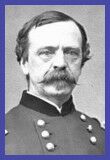
Daniel
Sickles
courtesy
General
Officers of the Civil War
I can
determine the troops faced the green uniformed Berdan Sharpshooters on both
days. These forces were the troops originally sent to The Foundry on day
one, and in his report Col Berdan states "...and reported to General Whipple.
I posted my First Regiment in the woods on the right of the Plank road, deploying
two divisions as skirmishers,..." General Sickles describes his front
line facing Hill as "The front line near the Plank road early in the morning
comprised, beginning on the left of the road, the Third Maryland (Twelfth
Corps), First Massachusetts, Fifth Excelsior, One hundred and twentieth New
York, the Second, First, and Third Excelsior, and Twenty-sixth Pennsylvania
(Second Division, Third Corps). This line gallantly resisted the assaults
of the enemy for more than an hour..." (The 3rd Excelsior was the
72nd New York Infantry, the first was the 70th NY under command of Carr)
Maps show that Thomas faced Carr, of Sickels Corps that morning, which would
have been the 26th Pennsylvania and New york troops. After this, it gets
very confusing. Thomas and his Georgian's would hit three separate lines
of resistance that morning, and therefore different Union units each time.
The Southern lines would be reinforced from behind by the brigades under
Colston and Rodes. So who exactly was fighting who, is difficult to determine.
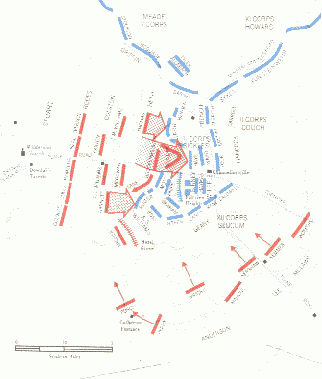
Probably
more interesting to examine is how close Thomas, on the extreme left of
Jackson's, now Stuart's line... was to the entire V Corps under George Meade.
Meade was in perfect position to attack their flank but didn't. Hooker wouldn't
allow it. And thanks to the Union armies inability to move when they could
have, most of the 35th and Thomas' Georgian's lived to see another
day.
Pictorial
tour of the battlefield
Maps of the Battle
Report of Brig. Gen. E. L. Thomas,. C. S. Army, Commanding Brigade.
APRIL 27-MAY 6, 1863.--The Chancellorsville Campaign.
O.R.-- SERIES I--VOLUME XXV/1 [S# 39]
HEADQUARTERS THOMAS' BRIGADE, May 19, 1863.
Capt. R. H. FINNEY,
Assistant Adjutant-General.
CAPTAIN: I have the honor to report that this brigade was ordered by
Major-General Hill, on the morning of May 2, to leave its position near
Chancellorsville on the right of the Plank road from Fredericksburg to
Gordonsville, and move with the division; in accordance with which order
we moved with the division a few miles, when a message was received that
the enemy had attacked, and were threatening to capture, artillery and wagon
train of the division near the foundry. One regiment was at first sent, but
the danger being reported to be most imminent, afterward the whole brigade,
with General Archer's brigade, returned, and remained until the train had
passed and the demonstrations of the enemy had ceased, when we moved on to
overtake the division, which we did about 11 o'clock at night.
The brigade was placed in position by General Heth, commanding division,
on the extreme left and front, on the left of the Plank road leading to
Fredericksburg and near Chancellorsville, where we remained until daylight.
At an early hour on Sunday morning, the brigade was ordered to advance and
attack the enemy. We advanced at once, driving a very heavy force of skirmishers
before us. After proceeding about 250 yards, we found the enemy in strong
force in our front, behind breastworks. The brigade charged with promptness
and energy, and at the first charge drove the enemy, utterly routed, from
their entrenched position. Advancing still farther, we found a second line
of the enemy, which we at once drove from its position. This brigade and
one regiment from the brigade on our right (General Pender's) continuing
to advance, driving the enemy before us, met another line of the enemy. After
a sharp conflict, this line was repulsed.
At this point, finding that there were no troops on my left and none in
supporting distance on my right or rear, and the enemy were advancing in
very heavy force on my left flank, and making demonstrations on my right,
I ordered the brigade to move back, and took position near the line of the
enemy's breastworks, where we remained until the whole line advanced. When
the enemy had been driven back at every point, the brigade, according to
orders, rejoined the rest of the division.
I take pleasure in reporting that Col. R. W. Folsom, Fourteenth Georgia;
Lieut. Col. W. L. Grice, Forty-fifth Georgia; Maj. S. T. Player, Forty-ninth
Georgia, and Capt. John Duke, Thirty-fifth Georgia, commanded their respective
regiments with marked success. All the officers and men of my command who
were present acted with the utmost coolness and the most daring courage before
the enemy.
I have to regret the loss of several valuable officers. Captain [Robert P.]
Harman, Fourteenth Georgia, and Captain [W. H.] Shaw, Forty-fifth Georgia,
were killed, and Lieutenant-Colonel [James M.] Fielder, Captain [T. T.] Mounger,
and Lieutenant [H. A.] Solomon fell, mortally wounded, within a few yards
of the enemy's-breastworks, gallantly leading their men to the charge.
Respectfully, your obedient servant,
EDW'D L. THOMAS,
Brigadier-General.
Battle
of Chancellorsville
Note - Chancellorsville was not an actual town. It was primarily an inn run
by a Mr Chancellor, who had envisioned a town. Located 12 miles from
Fredericksburg, it sat in the middle of the Wilderness where 5 roads
met.
 Chancellorsville
Battlefield
Chancellorsville
Battlefield
35th
Georgia Index |
